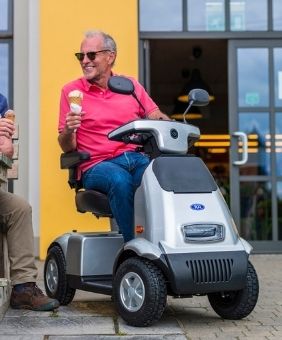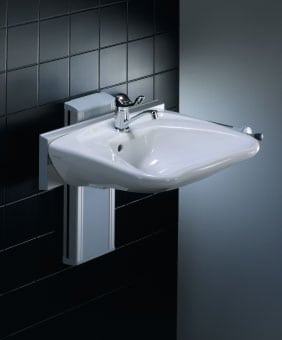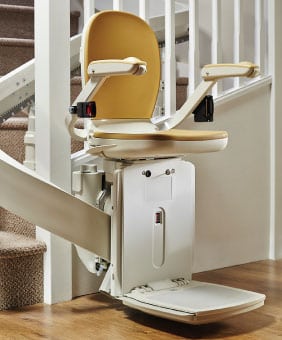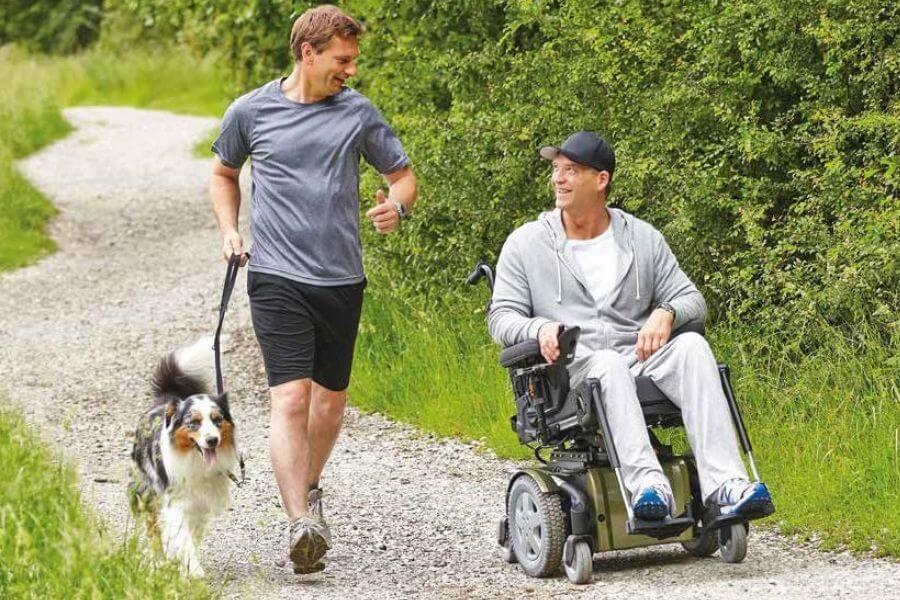Electric wheelchairs are powered mobility vehicles designed to get you around safely and comfortably, both indoors and outdoors. Electric wheelchairs are a versatile solution for those of us who stay in your wheelchair throughout the day, have restricted mobility in your hands, and are unable to transfer in and out of a chair easily.
Electric wheelchairs are also called powered wheelchairs or powerchairs. They take the strain out of self-propelling or having an attendant push you, as is the case of manual wheelchairs. The ability for the user to get from A-B unaided can really help you develop a more independent lifestyle, increase quality of life, and can bring a sense of freedom that really is priceless.
The benefits of electric wheelchairs
• Suitable for all users
• Comfortable and effortless to use
• Enable users to move and travel independently
• Range of electric wheelchairs suit various lifestyles
• Can increase confidence and happiness
• Mobility boosts feeling of freedom
Choosing the right powerchair for you
They say that choosing the right bed is crucial because of how much time we spend asleep. Well that’s exactly the reason why selecting a powered wheelchair is so important! Your power chair should fit your body size and shape perfectly. It should be comfortable. It should be equipped with the functions that complement your lifestyle, by supporting you throughout your day to day activities.
We group wheelchairs into the following 4 categories. Deciding between these will be based on a number of factors; the level of support you require from your chair, the lifestyle you lead, how much time you spend in your chair, and whether you take your chair with you when you travel locally, or further afield.
1. Standard Electric Wheelchairs
Standard electric wheelchairs are versatile mobility vehicles designed to get you around safely and comfortably, both inside your house and outdoors. They are a fantastic solution for wheelchair users who cannot wheel themselves, who spend a significant amount of time in a wheelchair and are unable to transfer in and out of the chair easily. They are available in a range of drive bases, seating systems and controls.
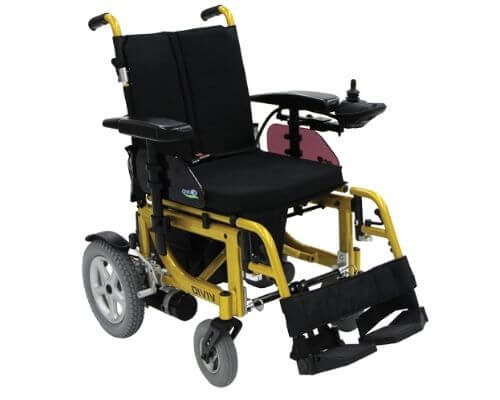
Kymco Vivio – Standard Electric Wheelchair
2. Configured Electric Wheelchairs
Configured electric wheelchairs, or prescription electric wheelchairs, have specialist and customisable features that are designed to give total support to the user, based on their individual needs and medical conditions. Such features can include support for arms, the head and neck, and height adjustable postural support.
Considering your future needs is crucial. If you have a medical condition that is expected to deteriorate, you may wish to choose a configured powerchair, even though you don’t immediately require the full extent of it’s specialist configuration capabilities. This will enable you to customise and adapt the chair in the future. This may also influence your decision on choosing a powered wheelchair over a manual wheelchair.
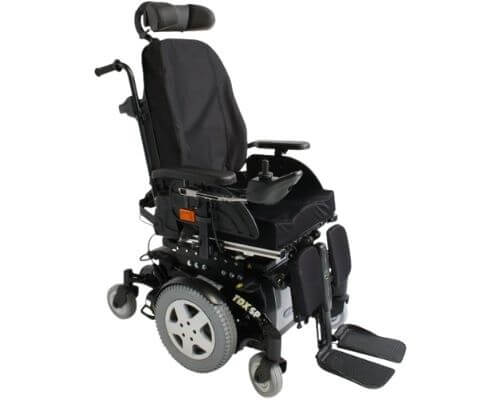
Invacare TDX – Configured Electric Wheelchair
3. Folding Electric Wheelchairs
Folding electric wheelchairs can be folded away in just a few seconds. This means they can be stowed away in home closets, storage cupboards, or even in hallways – to make room in houses where space is at a premium. Folding electric wheelchairs enable owners to store their wheelchair in lobbies or hallways of their home, without getting in the way or blocking the hallway entirely.
Once folded up, the wheelchair will fit nicely in the boot of the car, perfect for a day trip to the seaside, park, or a loved one’s home. This gives you the freedom to travel further afield independently, as no one has to push you, as is the case of folding manual wheelchairs. Lightweight electric folding wheelchairs offer a reliable, comfortable and transportable solution for users to travel away from home, as they can bring their wheelchair along with them on trains and aeroplanes. This opens up a world of opportunities for mobility when holidaying and travelling; a privilege that can be so easily taken for granted.
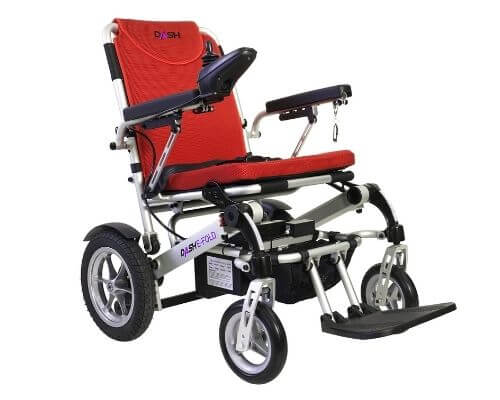
Dash E-Fold – Folding Electric Wheelchair
4. Standing Electric Wheelchairs
Standing wheelchairs feature a mechanism that brings the user to a standing position whenever they choose. Standing is an effective way to promote greater independence and reduce the risk for secondary complications associated with long-term sitting in wheelchairs. Standing electric wheelchairs should be prescribed for wheelchair users who want to benefit from standing but cannot stand independently. The proven physical benefits of standing electric wheelchairs includes;
• Improved breathing function
• Stimulates blood circulation around the body
• Helps prevent pressure ulcers and sores
• Promotes healthy digestive functions
• Helps strengthen the bones
Standing wheelchair users have praised the psychological benefits they experience. Users have said they feel more socially accepted and less handicapped when standing, as they are brought to eye-level with their surroundings. They enjoy the adaptability of being sat at dinner one moment, then joining their standing friends at a bar the next. The ability to participate in different social activities in the upright position has given wheelchair users better self-esteem and improved quality of life.
Standing powered are available in a range of drive bases, seating systems and controls. Sync Living are the exclusive supplier of LEVO standing wheelchairs in Ireland, and truly believe that their standing electric wheelchairs, such as the LEVO C3, are the very best on the market.
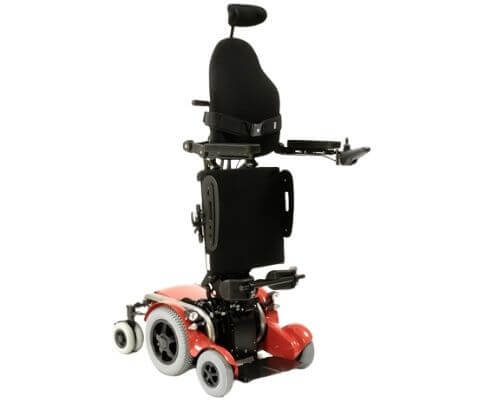
LEVO C3 – Standing Electric Wheelchair
Where can I ride my electric wheelchair?
Electrically powered wheelchairs fall into 2 categories; Class 2 and Class 3 vehicles. The differences in weight and power (and thereby speed) of the two enable them to access different environments, but they also have different legal requirements for the driver. Class 2 electric wheelchairs are generally smaller, lighter and less powerful. They are designed for indoor and outdoor use, however they cannot legally be used on the road (except where there is no pavement or to simply cross the road). Class 3 electric wheelchairs have a number of additional safety requirements to allow road use. They must be registered with the DVLA, and the user must be aged at least 14 years. Class 3 vehicles are not allowed on motorways, bicycle tracks or bus/cycle lanes, but are legally allowed on dual carriageways.
Class 2 wheelchairs can only be used indoors, or outdoors on the pavement. They are not allowed on the road.
• They have a maximum speed of 4mph.
• Users aged 14 years old and under are restricted to Class 2 products only.
Class 3 wheelchairs can be used both indoors, outdoors, and on the road.
• These chairs can travel up to 8mph on the road, although must only be driven at 4mph on pavements.
• When driven on the road, they must obey all requirements and regulations as other road users.
• They must have lights, rear view mirror, hazard indicators and a horn.
• They must be registered with the DVLA.
If you are looking for an electric wheelchair with the sole intention of driving it on the road, you may wish to consider a Large Road Mobility Scooter. Road mobility scooters are larger and better equipped for road use.
Electric wheelchair seating
For anyone who requires a wheelchair, the first stage is to access a full seating assessment from an occupational therapist or physiotherapist skilled in this area of work. If you have specialist needs it is vital that you have a professional assessment in order to get the correct chair and seating. You can be referred to your local wheelchair service via your GP or another healthcare professional.
The key to stability is a neutral pelvic position. This needs to be taken into account when fitting the seat positioning of a wheelchair. In a sitting position, the natural curves of the back and neck should be supported; and the shoulders, pelvis and knees should ideally be level. This does however depend on the individual needs of the user, and whether they have postural control – the ability to control their body position. The seat width, seat depth, seat height, backrest height and armrest height are all crucial here. There really is a science between how all these factors come into play; which is why you should seek a seating assessment from an occupational therapist or healthcare professional.
When seated for a long period of time, wheelchair users can also experience discomfort in the form of wheelchair skin conditions and pressure ulcers. Specialist cushions such as Stimulite contoured cushions, provide total pressure management. Stimulite cushions combat pressure injuries with their complete approach to pressure management. Pressure, shearing and maceration – softening of the skin due to heat and moisture – are the primary causes of pressure injuries. Stimulite cushions uniformly distribute pressure through their cellular matrix. The cells flux with movement to reduce shearing and are perforated to prevent heat build-up, and evaporate moisture. This keeps the user cool and dry, and helps prevent pressure sores. View our range of wheelchair seating here.
Consider transfers when setting your electric wheelchair height
When you are choosing your wheelchair seat height, then you should consider how this will affect you transferring in and out of the wheelchair. If you cannot perform a standing transfer, then the wheelchair seat height (including cushion) should be similar to the height of destinations you commonly transfer to. This means the height of your toilet, sofa, armchair or bed. It is a lot easier to transfer across, than it is having to lift yourself up or down. This seemingly small consideration will save you a lot of effort in the long run!
Front or rear wheel drive electric wheelchair?
Electric wheelchairs come with either 4 or 6 wheels. The drive in four wheeled electric chairs can either be rear wheel drive or front wheel drive. For six wheeled power chairs, there are also mid wheel drive models available. There are benefits to each of these systems and you should choose based on how you plan on using the chair.
Rear wheel drive invariably provides more power and better traction, as most weight tends to be over the back wheels. This is great if you plan to use the chair outside over larger distances. When you turn rear-wheeled drive electric wheelchairs, the front tends to swing out. Read wheel drive chairs tend to offer the most intuitive driving experience.
Front wheel drive electric wheelchairs usually have a smaller turning circle, which means they are very manoeuvrable. This is perfect for those using their wheelchair in small rooms and navigating tight spaces. When you turn front-wheeled drive electric wheelchairs the rear wheel can swing out slightly.
Mid wheel drive (6 wheeled chairs) can often turn on the spot, but their overall length is typically longer, meaning they require more space.
Control and operating your electric wheelchair
Your electric wheelchair is usually controlled by instruments that sit at the end of the armrest by your hand. The best control for you will be governed by movement, strength and dexterity that you have in your hands. Joystick controls are the most common, and suit the majority of users. They are easy to use, and allow you to make all necessary manoeuvres. If it is your first time driving a powerchair, then it might be worth doing some simple training exercises, particularly before you drive the chair around in public spaces. Driving the chair regularly will allow you to soon master the controls, but it is still easy to make a mistake that can cause damage – so do take care.
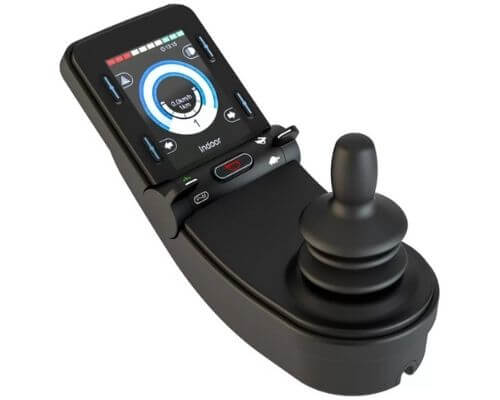
If you are unable to operate a joystick, then there are other instruments available. Alternative Access Controls are specialist devices that include touchpads, head controls, chin controls, tongue controls (a dental mouthpiece that is affixed to the roof of your mouth), and breath controls (controlled by inhaling or exhaling).
Charging your electric wheelchair
Remember the golden rule of electrically powered wheelchair ownership – keep it charged! Electric wheelchairs are very heavy, and you don’t want to run out of power mid journey. Powerchairs batteries do have a good range, on average about 10 miles per complete charge (this does vary, so do check the individual model specs). Here’s a few top tips to make sure you avoid running out of charge!
• Establish a regular charging routine.
• Store your wheelchair close to a power socket, so plugging it in requires minimal effort.
• Avoid letting the batteries run completely flat – give yourself a safety net!
• Always use the proper charging cable (this will plug into a standard mains socket).
• Charge based on use! If you use it daily, then overnight charging will be required. If you use the chair less often, weekly charging may be sufficient.
Electric Wheelchairs For Sale Northern Ireland
We supply a wide range of electric wheelchairs from the world’s leading brands; including;
• Kymco Electric Wheelchairs
• Invacare Electric Wheelchairs
• Pride Electric Wheelchairs
• TGA Electric Wheelchairs
• Permobil Electric Wheelchairs
• Dietz Electric Wheelchairs
• LEVO Standing Electric Wheelchairs
We understand that everybody’s needs are different, which is why we have a team of product specialists ready to help with any questions you may have. You can speak to us by calling +44 (0) 28 9074 5333, or send us a message through the website. We look forward to hearing from you!

